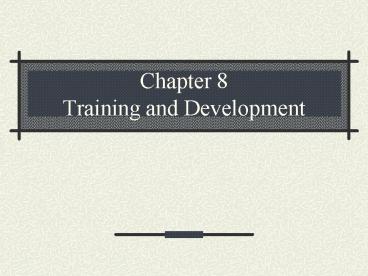Chapter 8 Training and Development PowerPoint PPT Presentation
1 / 15
Title: Chapter 8 Training and Development
1
Chapter 8Training and Development
2
Training
- A set of planned activities on the part of an
organization to increase the job knowledge and
skills or to modify the attitudes and social
behavior of its members in ways consistent with
the goals of the organization and the
requirements of the job.
3
Typical Steps in Creating a Training Program
- Conduct needs assessment
- Determine instructional objectives
- Design develop training
- Implement training
- Evaluate effectiveness
4
Needs Assessment
- Need is described as a "gap" between what is
currently in place and what is needed, now and in
the future - Gaps or discrepancies can exist between
- what the organization expects to happen and what
actually happens - current and desired job performance
- existing and desired competencies and skills
- Has three components
- Organizational Analysis
- Task Analysis
- Person Analysis
5
Organizational Analysis
- Analyzes the effectiveness of the organization
and determines where training is needed and under
what conditions it will be conducted - Identifies
- organizational goals
- state of the economy and the impact on operating
costs - resources available (financial, human)
- climate and support for training
- Changes in workforce demographics, technology,
political trends
6
Task Analysis
- Provides data about a job or a group of jobs and
the knowledge, skills, attitudes and abilities
needed to achieve optimum performance - Sources of information
- Job descriptions
- Task/KSA analyses
- Employee questionnaires, interviews
- Performance Evaluations
- Observation of behavior and results
7
Person Analysis
- analyzes how well the individual employee is
doing the job and determines which specific
employees need training and what kind - Sources of information
- Employee questionnaires, interviews
- Performance Evaluations
- Skill and Knowledge testing
- Observation of behavior and results
8
Training Methods
- Two most frequently used
- Lecture one-way communication, so learner is
passive - On-the-job training
- Programmed Instruction
- Self-paced
- Can often be completed more quickly than group
training - Can be delivered via computer (CAI) be made
adaptive - Costly to prepare
9
Training Methods (cont.)
- Simulations
- Case Studies trainees analyze problem outlined
in a report and offer solutions - Role Playing used primarily for developing
human relations skills, done by acting out
simulated roles - Behavioral Modeling trainees observe proper
work behavior then role play
10
Transfer of Training
- The extent to which the knowledge, skills, or
attitudes learned in training will be utilized or
applied on the job - Ways to increase probability of transfer
- Maximize similarity between training situation
and job situation - Provide a variety of examples when teaching
concepts or skills - Reward trained behaviors and ideas on the job
11
Evaluation of Training
- Reaction Criteria - evaluating the reactions of
participants - Learning Criteria - measuring the learning that
occurred - Behavioral Criteria - assessing on-the-job
behaviors - Results Criteria - Identifying impact of training
on business measure results - ROI - Calculating the return on investment
12
Business Results
- Examples of Hard Data
- Productivity measures
- Quality measures
- Materials costs
- Absenteeism turnover
- Customer satisfaction index
- Examples of Soft Data
- Improved job satisfaction
- Improved teamwork
- Increased organizational commitment
13
Training Evaluation Designs
- Design 1
- Training Posttest
- Design 2 pretest-posttest design
- Pretest Training Posttest
- Design 3 - pretest-posttest control group design
- Pretest Training Posttest
- Pretest Posttest
14
Solomon Four-groups Design
- Training Posttest
- Pretest Training Posttest
- Pretest Posttest
- Posttest
15
Situations Where Litigation is a Possibility
- Use of training as a job prerequisite
- Use of instruments to select people for training
- Use of training performance or graduation as a
selection criteria for another job - Use of training as a basis for increased
compensation - Use of training which restricts access to persons
with disabilities (ADA)

